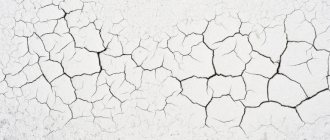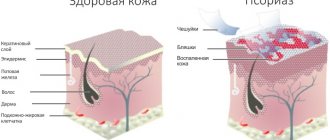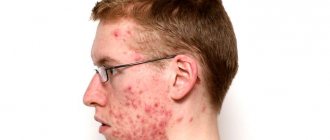Such a question as caring for oily facial skin usually worries girls under 25 years of age, but cases where a woman suffers from constant oily shine even after 40 years are no exception. Oily facial skin does not age for a long time, but the regular appearance of acne, flaking and shine, of course, does not please its owner.
Cleansing, toning, and using special masks and creams will help maintain skin balance and avoid oily shine. You just need to make sure that there is no mistake in determining your skin type and choose the right skin care products.
We will help you understand the causes of the problem, as well as choose the right cosmetics to care for oily skin. With a balanced and comprehensive approach, you will definitely notice improvements! But do not forget that advanced cases require a trip to a specialist and cannot be solved with home efforts.
Why do you have oily facial skin?
This problem is first encountered during puberty. This is when teenagers begin to suffer from acne, constant shine, especially in the T-zone, and other problems. The culprit of all this is hormonal changes in the body, or rather increased production of testosterone. Subsequently, the situation either evens out, or oily facial skin continues to require special care.
Another reason for the constant appearance of oily shine and related problems can be stress or poor nutrition. You should not abuse diets - the skin will begin to produce even more sebum. Nutrition should be balanced, and only then can oily facial skin type come closer to combination and even normal, with proper care, naturally.
Dehydrated skin
If your skin feels tight after washing with plain water, it means it is dehydrated. Usually this phenomenon is a consequence of a violation of the lipid membrane of the epidermis, which ceases to cope with its functions.
Why does skin dehydration occur:
- Due to the environment - constant dryness indoors or extreme weather conditions compromise the integrity of the skin;
- Improper care - due to aggressive cleansers, incorrect makeup remover and cosmetics, the skin becomes dehydrated;
- Dehydration causes loss of moisture in the skin. The norm of clean water per day starts from 1.5 liters, few people stick to it.
Care for dehydrated skin
To restore normal skin moisture, you will have to strictly follow several rules. Firstly, you need to exclude soap, alcohol tonics, scrubs, peelings, clay masks, acid cosmetics, baths, washing with hot or cold water from your care.
Moisturizing serums based on hyaluronic acid must be added to the care. They should be used twice a day after cleansing the skin. Then, fabric or hydrogel moisturizing masks are used every day for two weeks. Then, as the skin recovers, you can use them twice a week.
Cream for dehydrated skin must be selected individually, since dry, oily, or combination types can be dehydrated.
For dry skin, creams with moisturizing and nourishing ingredients are needed; vegetable oils, squalane and ceramides are suitable as the latter. For oily skin, light textures are suitable: fluids and gel-like creams that do not contain mineral oils and comedogenic components. For a combination, you need two products: a mattifying fluid for the T-zone and a universal moisturizer.
How to understand whether your skin type is oily or not?
It’s not difficult to understand – just carry out a special test. You need to wash your face with water and soap, preferably baby soap. You should not choose gel or products containing cream. The water should be cool without additives. After washing your face, pat dry with a towel. After waiting 3-4 hours, you can start the test. You need to apply a dry paper napkin to your face and inspect it. If there are oily spots on it, you should choose care for oily and problematic skin. Their absence indicates that the skin is most likely dry or normal. If they are located only in the T-zone, the skin may be combination.
Age should also be taken into account when choosing skin care products. Young consumers of cosmetics need certain products labeled “for young skin,” and care for oily skin after 30 years should be radically different. Both the quantity and level of cosmetics used change.
Signs of facial skin tightness
As we said above, tightness of the epidermis is primarily a constant pulling sensation, but the condition is accompanied by a number of other symptoms:
- Peeling
- depending on the degree of neglect, the problem can be either insignificant or very visible; - Unhealthy complexion
- often called grayish-pale, and the skin itself is described as tired and lifeless; - The appearance of wrinkles
—tightened dermis leads to premature loss of elasticity and the appearance of a noticeable network of wrinkles.
In addition, people with this problem often complain that they constantly want to wash or spray their face.
It is worth noting that today there are special devices for determining skin moisture that help assess the degree of dehydration. Of course, cosmetologists have such diagnostic devices, but they are often also available in premium cosmetics stores. By regularly doing tests you can prevent the problem.
Step-by-step care for oily skin
Proper care for oily skin begins with cleansing and looks like this:
- Washing using special gels or other products. It is better to take warm water (under no circumstances hot!), and at the end rinse your face with cool water. You can finish washing by wiping your skin with a piece of ice. To prepare it, it is better to use herbal decoctions or mineral water. But ice should not be used if you are prone to rosacea;
- Next, wipe the face with lotion or tonic. This gets rid of any remaining dirt and detergent;
- The next step is applying moisturizer. Oily facial skin also needs moisturizing just like dry skin. But you should choose the appropriate cream - light, with a minimum amount of ingredients that provoke the production of sebum;
- If there are pimples or inflammations, they should be treated with separate products.
- Now you can apply makeup. It is better to choose mineral cosmetics - they slightly dry out the skin;
- During the day, you should use special mattifying wipes if an oily sheen appears.
- In the evening, be sure to remove all makeup from your face. Then wash with gel or caring foam;
- After wiping your face with lotion, apply night cream.
This concludes the step-by-step care for oily skin. These are everyday actions, but care will not be complete without additional activities.
What to choose for oily skin – scrub or peeling?
Additionally, the skin is cleansed using a scrub or peeling. You can buy ready-made products or make them yourself. Both work effectively, but you should know that peeling cannot be used from mid-spring to mid-autumn to avoid the appearance of age spots. At this time, it’s better to stick to a scrub, but in winter it’s time for peeling. In any case, caring for problematic oily skin without them will be incomplete.
Superficial peeling can be used independently at home, but medium and deep peeling should only be applied by a cosmetologist. You can do it no more than 2 times a week. Fermented milk products, citrus zest and juice, oatmeal, soda, and honey are used as peeling.
Important! Peeling should not be used if there are rashes on the face. This can make the problem worse. Before use, be sure to test for an allergic reaction. The product should be spread on the inside of the wrist or elbow. If no manifestations of allergies (rash, burning) are observed, the product can be used.
Crabs perfectly cleanse and massage the skin of the face, but they also cannot be used for inflammation. Ground peels of nuts or apricot kernels, sea salt and other components are used as a scrubbing agent. The scrub is applied to damp skin, the face is massaged, and then the product is washed off with warm water. Apply 1-2 times a week.
The best masks for oily skin
The goal of applying masks is simple - moisturizing, cleansing and tightening enlarged pores. Of the purchased options, a film mask is best suited. It is applied to the skin, it hardens and is removed in the form of a film. Alginate masks are also good. When purchasing such a product, you should definitely clarify the composition and what type of skin it is intended for. But masks can and should be made at home. Compositions based on blue or green clay are ideal. It is diluted with warm water to the consistency of sour cream and other ingredients are added. This could be honey, fruit pulp, essential oils, and so on. There should be no cosmetics.
Mask recipes for oily skin
Whitening, slightly tightening mask
- - 3 tbsp. spoons of homemade yogurt or whey
- - 1 tbsp. spoon of baker's yeast (preferably not dry)
- - 1 tea. spoon of lemon juice
- - 5 drops of a 3% hydrogen peroxide solution (buy a ready-made solution at the pharmacy).
How to cook?
Mix the yeast and curdled milk well in a bowl, add lemon juice and then pour in hydrogen peroxide. Beat until you get a fluffy foamy mass.
Application
Apply a 1 mm layer to the face and leave for 10 minutes. Then remove the mask with a soft cotton swab and rinse with water without using detergents. Recommended for those who have blackheads on their skin, as well as women over 45 years old who have enlarged pores.
The following mask will help refresh your complexion and dry out oily skin.
- - 1 egg white
- - 10 grams of vodka or cognac
- - 1 tea. spoon of lemon juice.
How to cook?
Mix vodka and egg white until smooth with a ceramic pestle or beat with a wooden spoon, add lemon juice.
Application
Apply a 1mm layer to the surface of the face for 10 minutes. Wash with cold water without detergents.
Mask for aging and porous, oily skin
- - peel of 1 lemon, dried and crushed in a coffee grinder
- - 1 egg white
- - 1 table. spoon of oatmeal
- - 1 tea. spoon of lemon juice
Preparation
Grind the protein with ground peel, add lemon juice and oatmeal. Stir. If the preparation turns out to be thick, you can dilute it with cool boiled water (1 tablespoon) to obtain a homogeneous mixture.
Application
Apply to the face with massage movements (without much pressure) in an even layer for 15 minutes. Rinse off with cool water without using detergents.
Mask for oily, acne-prone skin
- - 1 tea. spoon of pomegranate juice
- - 1 tea. spoon of currant juice
- - 1 tea. spoon of lemon juice
- - 1 tea. spoon of cranberry juice
- - 1 table. spoon of baker's (dry) yeast. If the yeast is tableted, grind until a homogeneous mixture is obtained.
Preparation and use
Mix all products thoroughly in one bowl and immediately begin applying to your face using a brush or orange spatula. Keep for no more than 8 minutes due to the highly acidic environment. Afterwards, rinse with cold water (to quickly tighten pores) and apply cream-gel for oily skin to your face.
Degreasing mask
- - 25 grams of potato flour
- - 25 grams of sour homemade yogurt (it is not advisable to replace it with another product)
Preparation and use
Mix the ingredients until a homogeneous mass is obtained. Apply a thin layer to the face, leaving for 15 minutes. Rinse off with slightly warm water without detergents. Apply the mask 2 times a week, alternating with any protein mask.
To combat pimples, acne and oily skin, the following mask will help:
- - 1 table. spoon of cottage cheese with 1% fat content
- - 1 table. spoon of yogurt
- - 10 drops of vodka
Preparation and use
Mix cottage cheese with yogurt, add vodka and grind. Apply the paste to the surface of the face for 15-20 minutes, lightly wrapping it with a napkin. Afterwards, remove the mixture from your face and wash with cold water to close the pores.
Mask for porous skin
- - 50 grams of rye bread crumb
- - 50 grams of kefir
Preparation and use
Soak the bread in kefir and grind in a ceramic mortar until smooth. Apply a 1 cm layer to problem areas of the face, leaving for 30 minutes. Rinse off with cool water.
Tightening skin mask with whitening effect
Perfectly removes residual oil from the surface of the skin and is recommended before applying makeup for a long period of time
- - 1 egg white
- - 2 table. tablespoons crushed sorrel leaves (can be dry)
Preparation and use
- 1. Grind the egg white and sorrel.
- 2. Leave for 5 minutes to obtain a chemical reaction.
- 3. Apply an even layer to oily areas of the skin.
- 4. Leave for 15-25 minutes.
- 5. Afterwards, rinse with cool water. It is recommended no more than 2 times a week.
Care for oily skin at home
Home remedies work no worse than expensive store-bought ones. And their additional advantage is that a person knows exactly what is in the composition. High-quality ingredients guarantee excellent care for oily skin at home. You can make soap, make scrubs, masks, tonics and lotions.
Homemade Soap Recipes
Any soap contains a special base and additional ingredients. Soap making has become a fashionable hobby, and home-made products make excellent gifts. Sometimes regular unscented baby soap is dissolved as a base. Herbal extracts, oils (for example, rose), and ethers are added to the finished mass. Everything is thoroughly mixed, poured into molds and the mass hardens. Now you can use it. Sometimes scrubbing agents are added to soap. The best formulations contain citrus zest, oatmeal, ground into flour, and other ingredients.
Effective homemade scrubs for oily skin
Any scrub consists of small solid particles and a base that binds them. The latter is honey, clay, fermented milk products, for example, low-fat sour cream. And as an abrasive, soda, coffee grounds, sea salt, and cane sugar are used. The clay is diluted with warm water and exfoliating particles are added to it; sometimes a gel or foam for washing is used as a base. Do not apply such care products to oily skin if it is damaged or inflamed.
Homemade tonics
Toning lotions can also be made at home. The easiest option is to dilute the herbal infusion with alcohol in equal parts. The resulting tonic is used to wipe the face after washing. You can also make products to care for oily skin without alcohol, but they will have to be stored in the refrigerator. Some products in themselves are an excellent tonic; for example, you can wipe your face with lemon juice without any additives. Herbs used include chamomile, St. John's wort, wormwood and others.
Mask recipes for oily skin
Masks have a good effect on sebum secretion, are anti-inflammatory and cleansing. In addition, they eliminate other problems when caring for an oily face, such as wrinkles. You can limit yourself to one ingredient (strawberry pulp, kiwi), but it is better to choose components that successfully complement each other. The most popular homemade masks are as follows:
- Kefir (sour cream, yogurt) + banana pulp. Fermented milk products should be chosen natural and low-fat;
- Egg white with lemon juice. Has an excellent whitening and drying effect. And protein gives pore closure and a lifting effect;
- Yeast with kefir and honey. The face will be smooth and well-groomed.
They are prepared in the same way - all ingredients are thoroughly mixed (the egg white and juice are whipped until foamy) and applied to cleansed facial skin. Yeast is diluted in warm water and left for 15-20 minutes and only then everything else is added. Makeup is first removed from the face, masks are applied after washing and applying lotion. The optimal time for the mask to work is 20-30 minutes, then it should be washed off and the appropriate cream should be applied.
Homemade creams
They must be stored in the refrigerator, because there are no preservatives in natural cream. Ingredients: active substance, emulsifier, herbal decoction, base and essential oils, vitamins. Base oil (olive, wheat germ, grape seed, peach) should be heated in a water bath, add an emulsifier (sucrose stearate) and a decoction of herbs. Then cool and add the active substance (for example, yeast) and essential oil. The cream should definitely be tested on the crook of the elbow for an allergic reaction. You can also use pure oil - rose, jojoba and others, but not often. Caring for oily skin in winter differs from summer - this should be remembered. You can add beeswax to winter cream.
Causes of skin tightness
1. Negative environmental factors. Strong wind with wet precipitation, frost, cold rain, hot sun directly affect the skin, causing skin cells to shrink or expand, changing their condition and slowing down the regeneration processes in them. As a result, immediately after returning from the street you may feel severe irritation or tightness. The sun's rays also contribute to the evaporation of moisture and an increase in the number of free radicals, which provoke the development of skin diseases, including cancer. But in addition to the natural phenomena that so affect the condition of the integumentary tissues, the presence in the atmosphere, the air you breathe, of a huge number of chemical bonds that accumulate due to car exhausts and factory emissions also plays a significant role.
2. Insufficient skin nutrition. This can occur due to improper care, poorly selected creams and tonics, which not only do not care for the epidermis, but also provoke the development of problems such as increased dryness, tightness, or, on the contrary, increased fat content.
3. Washing with soap. Classic soap can be used for morning and evening washing, but not every day. Otherwise, the natural functioning of the sebaceous glands is disrupted and immediately after washing the skin begins to tighten. With regular use of soaps and highly alkaline products, dry and flaky skin becomes a constant problem.
4. Side effects from taking certain medications and dietary supplements. The main reason in this case is an allergic reaction or non-compliance with recommendations for taking medications and nutritional supplements.
5. Poor nutrition. Lack of nutrients and vitamins is one of the main factors causing dryness and tightness of the skin. Disruption in the functioning of the gastrointestinal tract, which is formed due to an unstable poor diet, provokes a deterioration in the condition of the integumentary tissues - pimples and rashes appear, sensitivity increases, peeling, and itching.
6. Insufficient fluid intake during the day.
7. Tightness and dryness can be clinical manifestations of a number of diseases.
8. Hormonal imbalance in the body, insufficient amount of amino acids to maintain optimal skin structure and cell nutrition. We are also talking about regular and seasonal disruptions in the functioning of the endocrine system - pregnancy, PMS, menopause, etc.
9. Poor-quality cosmetics and clothing that cause dryness of the epidermis.
Professional care for oily skin in the salon
Peels work great. It is in the salon that you can make medium and deep options, but only in the cold season. One of the popular procedures is mechanical facial cleansing. Professional care also includes phototherapy, which helps remove scars and acne marks. Cosmetologists advise taking a course of biodermabrasion. With the help of some manipulations, the skin is cleansed, especially since this procedure is not at all traumatic.
A more complex and effective treatment is a fractional laser cleaning session. And of course, in any salon you can get advice and recommendations from professional cosmetologists that are worth following.
Additional care for oily skin with acne
If the acne is inflamed, under no circumstances should you carry out any type of cleansing. You should first remove the inflammation (cure acne), and only then use a scrub or peeling. Pimples and blackheads are treated with special products that are applied pointwise. They usually contain zinc or salicylic acid.
How to remove acne?
Under no circumstances should they be squeezed out, especially with dirty hands or when they are inflamed. If the head has already come out, you should steam the skin and carefully remove it. Then you can squeeze out the remains (until the first drop of blood) and thoroughly disinfect the acne area with special products, for example, alcohol lotion or tea tree oil. The purulent stem of aloe and ordinary laundry soap are good for drawing out.
How to get rid of flaking after washing
If after water treatments you feel an unpleasant tightness on your face and you have flaking, it is recommended to pay attention to the following tips that will help you quickly get your skin in order and avoid problems in the future:
- for washing, use special gels and foams that moisturize the skin;
- refuse to wipe your face with a towel, as thorough rubbing will injure the skin;
- After washing your face, it is recommended to wipe your face with a moisturizing toner and apply a light moisturizer;
- When choosing cosmetics, pay attention to its composition. For maximum hydration, cosmetic products must be free of alcohol and lanolin, which dehydrate the skin;
- Before going outside, be sure to use a protective cream;
- protect your face from aggressive environmental influences;
- ventilate the room, humidify the air;
- drink the right amount of fluid per day;
- include more fresh fruits and vegetables in your diet.
These simple rules will help you avoid flaking of your facial skin. This will prolong youth, preserve beauty, eliminate the appearance of wrinkles and other imperfections.










